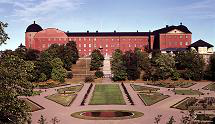Speaker
Dr
Daniel Barna
(University of Tokyo, Japan)
Description
The precision of laser spectroscopy of antiprotonic helium (a helium atom with one of its electrons replaced by an antiproton) has improved by almost 4 orders of magnitude over its 20 years of history. Experimental transition frequencies can be compared to 3-body QED calculations to derive the antiproton-electron mass ratio.
In the latest measurements of the Asacusa experiment at CERN, two-photon transitions of antiprotonic helium were excited using two counterpropagating laser beams. This method reduces the Doppler-broadening caused by the thermal motion of the atoms, and allowed us to measure the transition frequencies with a fractional precision of 2.5-5 parts in 10^9. From these frequencies, we derived an antiproton-electron mass ratio of 1836.1526736(23). Our precision approaches that of the experimental value of the proton-electron mass ratio, and agrees with the latter within errors. Assuming CPT symmetry (i.e. $m_p=m_pbar), we further derived the electron's atomic mass as m_e=0.0005485799091(7)u from the more accurately known atomic mass of the proton.
Primary author
Dr
Daniel Barna
(University of Tokyo, Japan)
Co-authors
Andreas Dax
(University of Tokyo, Japan)
Anna Sótér
(Max Planck Institut für Quantenoptik, Garching, Germany)
Bertalan Juhász
(Stefan Meyer Institut für Subatomare Physik, Vienna, Austria)
Dezső Horváth
(Institute for Particle and Nuclear Physics, Wigner Research Centre for Physics, Hungary)
Eberhard Widmann
(Stefan Meyer Institut für Subatomare Physik, Vienna, Austria)
Luca Venturelli
(Dipartimento di Chimica e Fisica per l’Ingegneria e per i Materiali, Universita di Brescia & Institutio Nazionale di Fisica Nucleare, Brescia)
Masaki Hori
(Max Planck Institut für Quantenoptik, Garching, Germany)
Nicola Zurlo
(Dipartimento di Chimica e Fisica per l’Ingegneria e per i Materiali, Universita di Brescia & Institutio Nazionale di Fisica Nucleare, Brescia)
Ryugo Hayano
(University of Tokyo, Japan)
Susanne Friedreich
(Stefan Meyer Institut für Subatomare Physik, Vienna, Austria)
Thomas Pask
(Stefan Meyer Institut für Subatomare Physik, Vienna, Austria)

